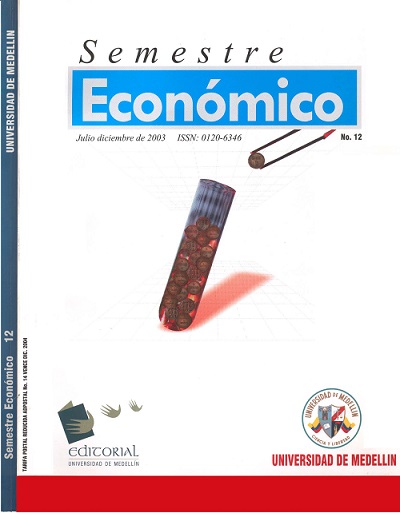La concentración industrial en Colombia: Determinantes de la movilidad y el desempeño empresarial
Main Article Content
Abstract
In Colombia, although for over a decade already, debates continué over the effects of open economy as a strategy that has influenced the country–s productive structure, the lack of knowledge on its advantages and disadvantages, as an industrial strategy enhancing competition ; is undeniable.
This article, which seeks to contribute to a better understanding of the structure and organization of markets, as well as the strategic behavior of the involved agents, consists of three parts. The first one addresses the theoretical issues enclosed around the research over the enterprise mobility, its determinants, the ways to entering a market, and industrial concentration; while in the second part, an approach to the Colombian case of enterprise mobility is carried out, for each one of the industrial classes, and its influence on generating employment. Finally, the most relevant conclusions of this paper are synthesized.
Article Details
References
Arauzo, Joseph Maria; Manjón, Miquel; Martín, M.; Segarra, Agustí. ( ).- 'entrada y salida de empresas; un contraste de las hipótesis de independencia, simetría y simultaneidad'. Universitat Rovira iVirgili. Facultad de Ciencias Económicas y Empresariales. 29p
Audretsch, David B.; Acs, Zoltan J. (1991a): 'Innovation as a means of entry: an overview' Geroski, P. A.; Schwalbach, J., (eds): entry and market contestability: An international comparation. Oxford and Cambridge: Blackwell, 1991, Págs.:222-243
Baldwin, Jhon R. and Gorecki, Paul K. (1994): 'Concentration and mobility statics in Canada’s manufacturing sector' The journal of industrial economics. Vol XLII, Marzo 1994, Pags 93-103
Baldwin, John R.; Gorecki, Paul K. (1991): 'Entry, exit, and productivity growth' Geroski, R A.; Schwalbach, J., (eds): entry and market contestability: An international comparation. Oxford and Cambridge: Blackwell, 1991, Págs.:244-256.
Beacham A. (1952): Economía Industrial. Traducción directa de la segunda edición de Economics of Industrial Organization, Londres. PorSemascoV Elina, Ed. Prometeo, Buenos Aires, 1954.
Cabral, Luis (1997): Economía Industrial. McGraw-Hill. España. Primera edición. Pág.: 196
Campbell R., Jeffrey. (1997): 'Entry, exit, embodied technology and business cycles'. National Bureau ofeconomic Research. Working Paper Series 5955. Universidad de Rochester. 35p.
Carroll Charles, Padian J. R. M. and Howard Thomas (1994): ‘Assessing the height of mobility barriers: a methodology and an empirical test in the UKretail grocery industry' British \ournal of’Management. Vol. 5. Pág.: 1-18
Dixit K. Avinash; Kyle S. Albert (1985): 'The use of protection and subsidies for entry promotion and deterrence' American economic Review, 75(1). Págs.: 139-161.
Geroski, R A. (1991 b): 'Some data-drive reflections on the entry process' Geroski, R A.; Schwalbach, J., (eds): entry and market contestability: An international comparation. Oxford and Cambridge: Blackwell, 1991, Págs.:282-296.
Herrera, Mauricio; Ortega Gustavo (2003) 'La Movilidad Empresarial en la Industria Colombiana 1990-2000'. Junio de 2003.
Jacquemin, Alex (1982): Economía Industrial. Hispano Europea. Págs. 537
Jansen, Maarten; Rasmusen Erick (2002): 'Bertrand Competition under uncertainly' ]ournalof industrial Economic, March 2002 (1). Pág. 11.
Jovanovic, Boyan (1982): 'Selection and evolution of industry' econometrica 50(3). Págs.: 648-670.
Jovanovic, Boyan; Lach, Saúl (1989): 'Entry, exit, and diffusion with learning by doing' American economic Review, 79(4). Págs.:690-99.
Klepper, Steven (1996): 'Entry, exit, grow, and innovation over the product life cycle' American economic Review, 86(3). Págs.:562-583.
Ministerio de Desarrollo (2001). 'La dinámica de la industria manufacturera' Pablo Martí, Federico. (2000): La movilidad empresarial en la industria española. España, Tesis doctoral. Universidad de Alcalá Henares. Facultad de CC. Económicas y Empresariales. Economía aplicada. 613p.
Pablo Martí, Federico. (1997): La concentración industrial en la economía española: 1980-1992. trabajo de investigación, Universidad de Alcalá Henares. Facultad de CC. Económicas y Empresariales. Economía aplicada. 127p.
Segarra Blasco, Agustí. (2002): 'Supervivencia empresarial, ciclo de vida y régimen tecnológico'. Universitat Rovira i Virgili. Facultad de Ciencias Económicas y empresariales. 26p.
Tiróle, J. (1988)The Theory of Industrial Organization. Cambridge, MA: M1T Press. 479pp
Vickers, John; Yarrow, George. (1991) Un análisis económico de la privatización. Fondo de cultura económica. Primera edición.

